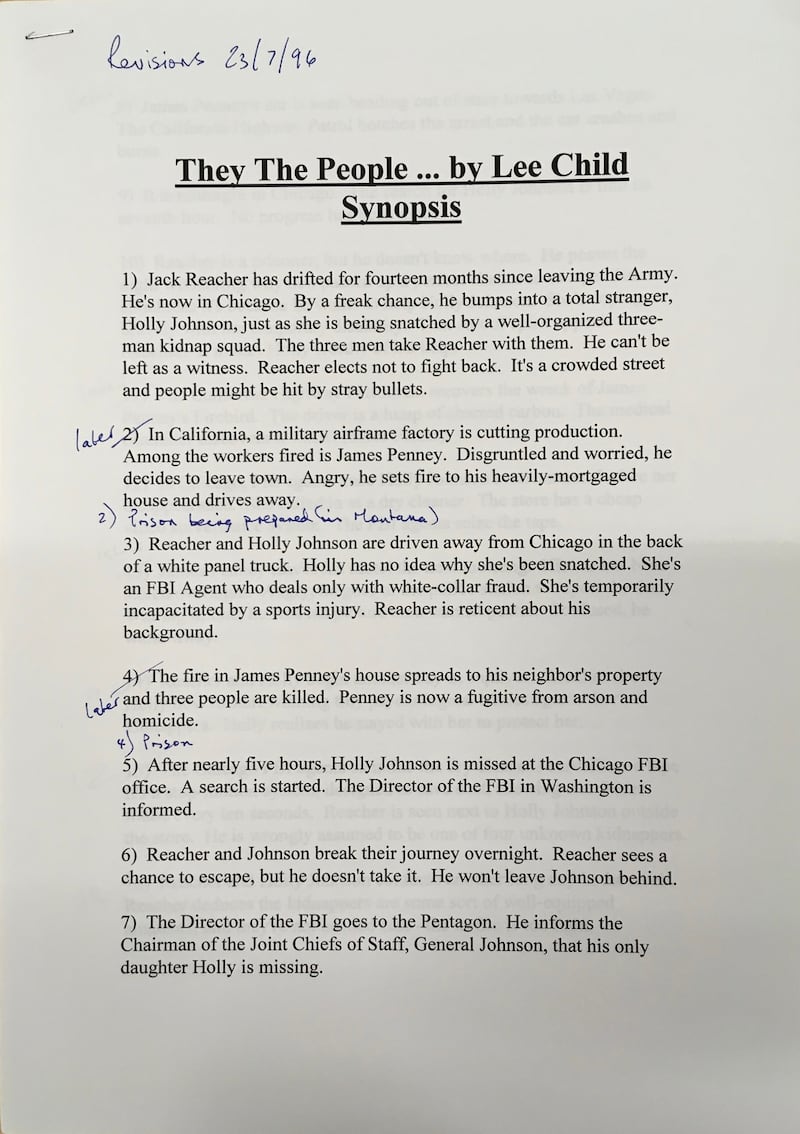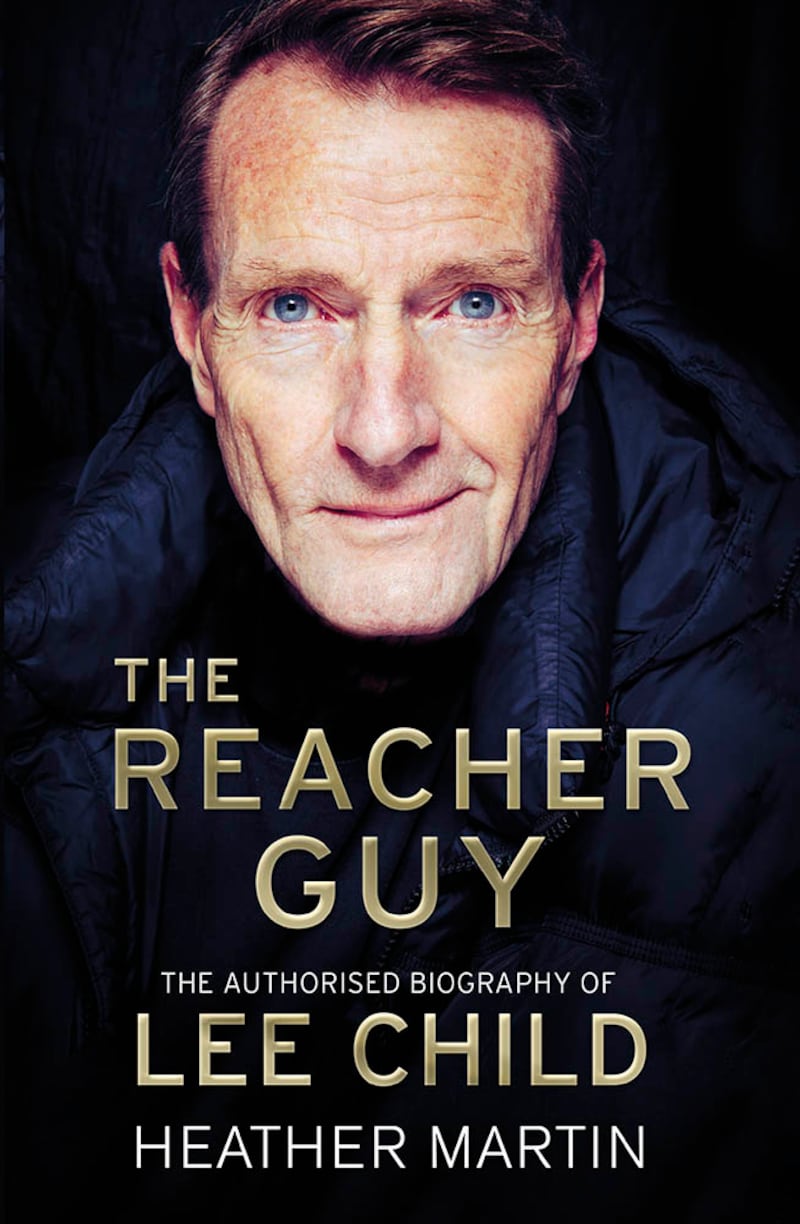One thing we all know about Jack Reacher is that he’s indestructible.
“There’s only one person in the world that Reacher is afraid of,” Lee Child said at the University of Nebraska in April 2018, “and that’s me.” But the truth is, Reacher, the bestselling hero of a series of 24 books (and counting), almost didn’t make it as far as book number two.
Child put the final touches to Killing Floor in March 1996. In April he started on Die Trying. He already had a hefty two-book deal with New York’s GP Putnam’s Sons, though he wouldn’t meet his UK publishers until May and his debut would not be published until the following March.

Like Child’s first novel, his second went through multiple drafts and started life under a different name. He spent months agonising over the title of his debut (“titles that try to sum up the book”, “titles that try to sum up Jack Reacher’”) - generating at least 62 possibilities across at least three different lists. His first choice, Bad Luck and Trouble (recycled for Reacher #11), was rejected by both agent and publishers as too negative.
They didn’t much like his second, either – too brutal! – but somehow Killing Floor stuck: “I’m reconciled to it,” his Transworld editor Marianne Velmans writes resignedly in August 1996, perhaps anticipating the Daily Telegraph’s trailer of the book as resembling “Kafka with violence”. So when the same problem looked like rearing its ugly head a second time round, Lee pledged to come up with something better “or die trying”. Great title! the publisher said, happily.
The original title of Reacher #2 was They, The People, succinctly summarising the focus on separatist and militia movements in Northwest America.
“I was fascinated by their self-serving mental gymnastics,” Lee recalled in his introduction to the 2013 Mysterious Bookshop collectors’ edition. “Total absence of evidence for wild fantasies was claimed to be definitive proof of their existence because only perfect government conspiracies could produce perfect cover-ups.”
He read False Patriots, a 1996 report by the Klanwatch Project of the Southern Poverty Law Center. He read The All Too Wild West (Sophisticated Traveler), an account of a family vacation in Montana; The Militia Threat (New York Times); The Madness of Middle America (Sunday Telegraph); and Good Ol’ Ranchers Gone Bad (Observer). Then he decided to go see for himself.
He packed his toothbrush, stuffed a roll of cash in his pocket and caught a plane from London to Seattle via Chicago, where incidentally he was struck by the number of dry cleaners. He rented a grey Ford Explorer and drove east through the Washington State badlands across the Idaho panhandle into Montana, as far as Kalispell and Whitefish.
“I stayed in twenty-dollar motels and ate cheap. I used truck stops and played pool in bars. I talked to all kinds of people – truckers, strippers, cops, farmers, FBI agents – and found my way into two separate militia encampments. I saw bears and coyotes and two-mile-long freight-trains, and never quite got used to the vast emptiness, which at times was scary.”
It was a great holiday, but he saw nothing to contradict what he had already imagined or read.


At the British Archive for Contemporary Writing (University of East Anglia) I found a long-form synopsis of They, The People itemising the contents of each chapter to a total of 64, annotated with detailed revisions. It’s a complex, multi-stranded narrative, following both the kidnap of Holly Johnson from outside a dry cleaner’s and the flight of James Penney, a roughly 40-year-old man with a heavily mortgaged house who, after 17 years of loyal service in one job, is fired from a company that is being downsized.
In Montana, where the plausible and patriotic head of a growing militia community is about to be overthrown after a “night of the long knives” by “head-down, balls-out fanatic” Robert Penney (son of James), their fates will converge. There’s a plot involving stolen missiles, missing from a downsized US Army; the FBI needs a “magic bullet”; only one man can save the day.
That man is … John Trent. Colonel John Pemberton Trent is a Special Forces officer on leave in Chicago. He has “some pretty unusual skills”.
The mind-blowing truth is, Reacher #2 wasn’t, in conception, a Reacher novel at all. Lee Child had said goodbye to Reacher when he left Roscoe behind in Margrave. There was to be no going back, for author or character.
The synopsis of They, The People continues:
Washington can’t countenance secession of US territory under such a leader. Neither can John Trent, witnessing events from the inside.
Frontal military assault fails. A Special Forces officer is required. The Army says John Trent is the man. But Trent is already in Montana. Nobody knows why. Nobody knows whose side he is on.
Alone, isolated, distrusted by both sides, Trent takes his own decision. Penney must be stopped. While Army units mass on the perimeter, Trent does what Washington would want him to do. He goes to work as a “magic bullet”, taking out the militia’s command structure, one by one. Secession fails. The militia is defeated.
John Trent sounds like a great guy. Not altogether unlike Jack Reacher. The same but different, which was what John Reginald Grant had told Jim he looked for in a good book, when Lee Child was starting out, like a magic bullet formula he had passed on to his second son.

But as a fictional hero Trent was doomed. Because however similar, the harsh fact remained that he was not Jack Reacher. Which was a shame, because the newborn Child had really worked at Reacher. At first he was but a sketchy blueprint: “This is vitally important. It will be make-or-break,” he writes under “Character of H”. H (for hero) “must be” an alienated outsider. He must have “some moral base albeit probably bleak & cynical to a degree”, and there must be “a very subtle portrayal of superhuman powers”. He “always knows better” and “things turn out OK”.
So far, so Reacher.
But there was plenty about the prototype that wasn’t Reacher at all. Literally. For a brief spell he was Franklin; then there was a fleeting dalliance with the initials L and J before the Grants made that famous trip to the Kendal Asda where unwittingly, as her husband reached down a can from the high shelf for a passing old lady, Jane gifted Child the Reacher name.
Worse, in the first draft of the opening chapters H is shockingly introspective – even wordy! Reacher needs to be more active, his first editor David Highfill writes; he needs to stop telling us his plan in advance of executing it – “Can he think about this in half the number of pages?”
Which is when the writer shifts the emphasis to point of view, including more descriptive and sensory detail, and Reacher becomes less explicit about his feelings, cooler and less hot-headed. He stops saying he hates people and muttering “smug bastard” under his breath. He stops analysing his shortcomings and agonising over his failures.
Once Reacher had dispatched this early sensibility he was truly invincible. No one could kill him off. Not Hook Hobie. Not Tom Cruise. Not even Lee Child, who rather than do so would bequeath the character to his younger brother. So it was that on the reverse of the synopsis of They, The People, in red ink, the still fledgling author wrote five, life-changing words:
“They want a Reacher sequel!”
Child rarely uses the exclamation mark. Which makes this one all the more poignant – a marvellous, faintly awe-struck moment of hardly-daring-to-believe-it realisation, the second best thing to the birth of his only daughter 16 years before, but also like he could hear the door clanging shut behind him, just as he had then. There would be no escaping Reacher, just as there was no escaping fatherhood. He was going down for an indefinite number of years (at least 21, if he were to match his early role model, John D MacDonald) – he might as well enjoy it.
The selling synopsis is confidently re-drafted. In the vast emptiness of northern Montana “a stranger is spotted in a surveillance photograph”.
A name is put to the face. That name is Jack Reacher. He’s in northern Montana. He’s been there quite a while.
The only question is: whose side is he on?
There are those who want him killed. There are others who trust him to do exactly what needs doing …
Or Die Trying.
It was at this precise moment that the billion-dollar brand that in 2014 Forbes magazine would declare the strongest in publishing, commanding the greatest reader loyalty, was born.
But Lee hated waste. And even as he bade farewell to John Trent he was loath to kill off Vietnam vet Penney, hard-working, hard-done-by casualty of ruthless company cuts, with vague links to Kendall south of Mojave, and thereby Kendal north east of Kirkby Lonsdale. It would be like killing off James Grant himself.
“I should have thought harder,” James Penney admits to Captain Reacher, both father-confessor and judge. “But I was real mad. Seventeen years and suddenly I’m shit on their shoe.”
Reacher didn’t have a problem with it. “A guy does a jungle tour, works seventeen years and gets canned, I guess he’s entitled to get a little mad.”
In the late nineties James Grant was also feeling a little mad. His tour at Granada Television had lasted 18 years and even in 2020 the anger at being sacked hadn’t entirely subsided. He would still wake up time to time having dreamed about it at night.
So when in 1999 crime-writing supremo Maxim Jakubowski commissioned what would be Child’s first short story, he dug James Penney out of the box he’d been languishing in and put him front and centre. Reacher appears only three quarters of the way through, picking Penney up in a dull olive Chevrolet sedan after a forty-ish hippy driving a Jeep (a red Cherokee was the car the forty-ish Lee bought when he’d moved to New York the year before) had first dropped him in Sacramento.

It was a crucial turning point in biographical and literary history. Thanks to public demand, James Grant had committed to his second Reacher novel. He was assuming his new identity, and would henceforth sign himself Lee Child.
Heather Martin's biography of Lee Child, The Reacher Guy, is published by Constable at Little, Brown in the UK and in the US by Pegasus Books on September 29th.


















